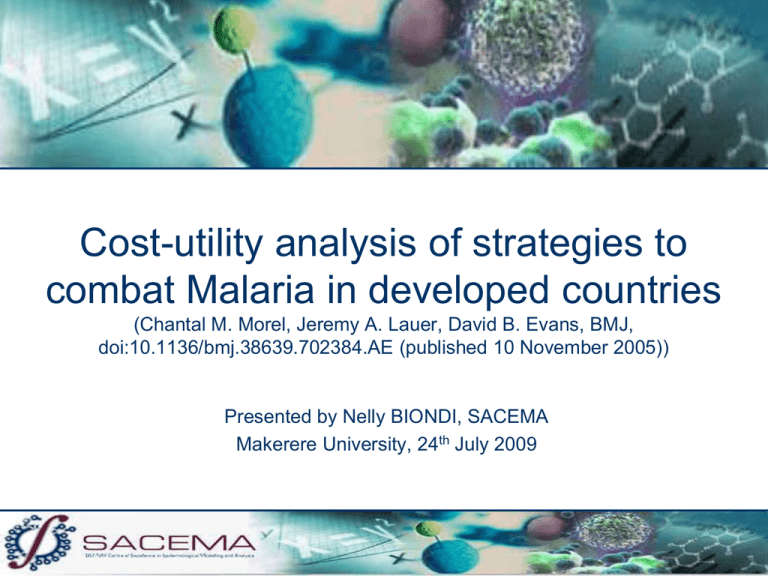Cost-utility analysis of strategies to combat Malaria in developed countries
advertisement

Cost-utility analysis of strategies to combat Malaria in developed countries (Chantal M. Morel, Jeremy A. Lauer, David B. Evans, BMJ, doi:10.1136/bmj.38639.702384.AE (published 10 November 2005)) Presented by Nelly BIONDI, SACEMA Makerere University, 24th July 2009 Background • Each year more than 1 million people, mostly children and pregnant women die from malaria worldwide. • Most of these deaths could be averted, as effective and affordable ways to prevent and treat malaria exist. • It is important to ask whether current interventions are used appropriately and what is the most cost-effective way to scale-up prevention and treatment activities to the levels needed. • The autors used a cost-utility analysis to examine the costs and the effects of scaling-up seven interventions against malaria and their promising combinations. 2 Methods Geographical focus • 90% of deaths from malaria occur in sub-Saharan Africa. • Focus on 2 sub-Saharan African regions: Afr-E (predominantly Southern and Eastern Africa) and Afr-D (predominantly Western Africa). • Both regions are predominantly areas with endemic high transmission of malaria due to Plasmodium falciparum. 4 Interventions • A limited number of means are available to fight malaria: 5 Population at risk and coverage • Interventions were evaluated at 50%, 80% and 95% target coverage to allow for unit costs and effectiveness that may vary with coverage. • Effective coverage = target coverage x population at risk. • Region-wide estimates of population at risk (proportion living in a malaria endemic areas) based on country specific figures. – 98% for Afr-D – 69% for Afr-E • Estimates of current coverage were used for calculating the null scenario. 6 Current coverage 7 Estimating the net effectiveness of interventions • The net efficacy of bed nets and indoor spraying were expressed as a reduction in incidence and thereby a reduction in mortality modelled through case fatality (table 2). • The net effectiveness of treatment was estimated taking into account: – Patients’behaviour (adherence to regimen) – Pharmacokinetics (probability of success when the regimen is not followed) – Biogenetics (resistance of the parasite to the drug). • These factors determine the number of expected failures which we substracted from a common baseline of 98% efficacy (table 3). • The net effectiveness of bed nets, but not spraying was reduced to account for imperfect adherence. 8 Baseline efficay 9 Net efficacy of the interventions 10 Population Model • The model combines estimates of incidence, prevalence and mortality with estimates of prevalence (table 5) and severity from the burden of disease study to project the population impact of intervention scenarios in terms of healthy years of live lived. • Differences in total population healthy years under the intervention and baseline scenarios are expressed as DALYs averted. 11 Estimating the costs of interventions • Estimated costs measure the value of resources needed to provide the intervention and are expressed in international dollars. • Costs were calculated in the light of experience from effectiveness trials, existing literature and expert opinions. • Costs were classified by programme costs or patient costs. Training costs were assumed to be a substancial part of malaria interventions so they have been reported separatly from programme costs. • The CostIt model (WHO,2002) was used to aggregate cost components and total costs for the 10 year implementation horizon. 12 Cost profile Afr-D 13 Cost profile for Afr-E 14 Results Cost-effectiveness estimates 16 Cost-effectiveness planes 17 Cost-effectiveness planes 18 Incremental and average costeffectiveness ratios 19 Incremental and average costeffectiveness ratios 20 Conclusion 21 The end…





